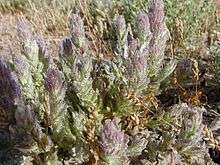Cordylanthus palmatus
| Cordylanthus palmatus | |
|---|---|
 | |
| Scientific classification | |
| Kingdom: | Plantae |
| (unranked): | Angiosperms |
| (unranked): | Eudicots |
| (unranked): | Asterids |
| Order: | Lamiales |
| Family: | Orobanchaceae |
| Genus: | Cordylanthus |
| Species: | C. palmatus |
| Binomial name | |
| Cordylanthus palmatus | |
| Synonyms | |
|
Chloropyron palmatum (Ferris) Tank & J. M. Egger [1] | |
Cordylanthus palmatus, now reclassified as Chloropyron palmatum,[1][2] is a rare species of flowering plant in the broomrape family. It is known by the common names palmate bird's beak, palmate salty bird's-beak, Palmate-bracted bird's-beak, and palmbract bird's beak.
Distribution
The plant is endemic to the Central Valley of California, where it is known from a few remaining occurrences in the rare alkali sink habitat type. The plant is limited to seasonally-flooded flats with saline and alkaline soils, where it grows with other halophytes such as iodine bush and alkali heath.[3]
It is a federally listed endangered species. The main threat to its existence is the destruction of its already naturally limited habitat, for agriculture and development uses, with other adverse effects from alteration in hydrology, off-road vehicles, and grazing of livestock.[3][4] The plant is currently known from 21 locations[5] in seven metapopulations.[3]
Description
Chloropyron palmatum is an annual herb growing 10 to 30 centimeters tall. It is gray-green in color, glandular, and coated with hairs. It is often encrusted with salt crystals it has excreted.
The sparse leaves are oblong and sometimes have lobes along the edges.
The inflorescence is a dense columnar spike of flowers up to 15 centimeters long. The bracts surrounding the flowers are leaflike and palmate in shape, with several lobes. Each flower is up to 2 centimeters long and has a fuzzy white pouch, sometimes tinted purple, enclosed in darker sepals.
References
- 1 2 "Chloropyron palmatum". Germplasm Resources Information Network (GRIN). Agricultural Research Service (ARS), United States Department of Agriculture (USDA). Retrieved 19 January 2018.
- ↑ Jepson eFlora (JM2): Chloropyron palmatum . accessed 8.28.2015.
- 1 2 3 CSU Stanislaus Endangered Species Recovery Program
- ↑ California Native Plant Society Rare Plant Profile
- ↑ Sacramento Fish & Wildlife
Further reading
- CNPS Inventory Plant Detail: Chloropyron palmatum
- Coats, R., et al. (1993). Management plan for an alkali sink and its endangered plant Cordylanthus palmatus. Environmental Management 17:1 115-27.
- Fleishman, E., et al. (2001). Rules and exceptions in conservation genetics: Genetic assessment of the endangered plant Cordylanthus palmatus and its implications for management planning. Biological Conservation 98:1 45-53.
